Demand Generation
What is demand generation? Discover demand generation marketing strategies and tactics from top teams. Get even more B2B demand generation tips in a free guide.
One of the biggest challenges for today’s brands is creating demand for products and services. That’s why demand generation (also known as “demand gen”) has become such a household name among B2B and B2C companies alike.
But don’t get us wrong. Demand generation isn’t about forcing demand or tricking people into buying things they don’t need. It’s about providing the right information to the right people at the right time with the confidence that what you’re offering is the perfect fit for your customers’ needs.
While demand generation marketing has a lot in common with lead generation, this strategy takes more time. It spans multiple touchpoints, campaigns, and marketing channels and includes just about anything your brand does to generate buzz, awareness, and recognition.
The end game? Better conversations between buyers and sellers, which lead to higher conversion rates and more closed deals.
Ready to learn? Let’s go.
What is demand generation?
Demand generation is a marketing strategy that includes any activity that drives awareness and interest in your product or service. The ultimate goal is to create a predictable pipeline that will grow your business.
To do this, demand generation marketers aim to identify potential prospects based on behavioral data and guide them through a nurturing process so that the sales team receives high-quality, highly-qualified leads.
Demand generation covers all your marketing and sales initiatives at every touchpoint in the customer’s journey — whether you’re generating interest among potential buyers or upselling to existing customers.
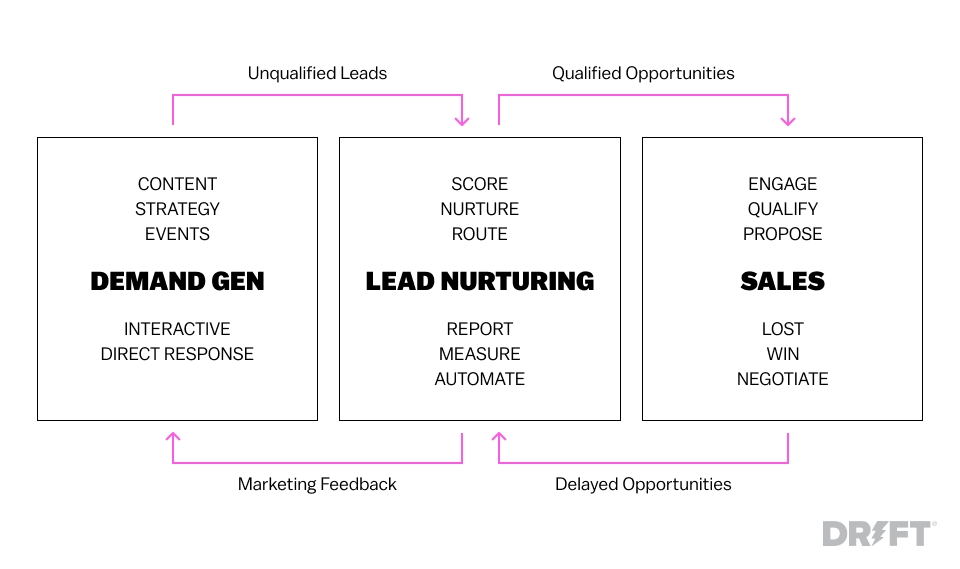
Our top 3 demand generation strategies
Demand generation strategy #1: Generating awareness with your target audience
Creating and promoting content is a big piece of any demand generation marketing strategy. After all, it’s one of the most reliable ways to drive users to your website and bring them further along the buying journey.
However, if your goal is to generate awareness, you need a slightly different approach. Instead, your focus should be to build trust, increase brand recognition, and position your brand as the “go-to” within your industry.
Building awareness goes beyond who you can get to write a guest post or the size of your social media following — all your marketing efforts should come together so that people will want your product or service. That means you need to be solving a problem — one that your prospects are currently struggling with or one they haven’t yet realized they have.
Demand generation strategies hinge on well-defined personas
The key to every successful marketing strategy is to offer solutions that speak to each specific buyer by addressing their unique pain points, readiness to buy, content preferences, and where they are in the sales cycle.
So, before you put pen to paper, start by defining the following:
- Who are your ideal prospects?
- How do they make buying decisions?
- What are their pain points?
- What questions do buyers typically have at each stage in the sales cycle?
Develop top-of-the-funnel content
At the beginning of the buying journey, the goal isn’t to sell — it’s to answer questions and educate prospects. Here, your job is to create content that helps people and generates interest — which, when done right, can position your brand as a thought leader and go-to resource in your niche.
We created the Learn Center to act as a resource hub for both internal and external users. There, you can find all our thought leadership content, such as an introduction to Conversational Marketing (a category we created!) and AI chatbots.
We also provide resources that cover a wide range of topics, like this one:
Public relations
After you’ve developed an understanding of your buyers and their journey, you’ll also want to learn which websites, industry publications, and other resources they turn to as they work toward making a buying decision. An intelligent public relations strategy helps brands generate buzz, build trust, and reach more people than your content strategy alone. Strong public relations fuels demand generation.
Create a free tool
Free calculators, hashtag generators, and evaluation tools — a good way to create demand for your core product or service is by creating a free tool that relates to the pain point your brand solves.
Examples of free tools for B2B demand generation include Coschedule’s Headline Analyzer, WordStream’s Google Ads Performance Grader, and SproutSocial’s social media image resizing tool.
Demand generation strategy #2: Converting & monetizing existing in-market demand
After you’ve put your awareness-boosting strategies in place, the next step is to capture existing demand. Now, your aim is to reach the people actively searching for the solution you provide using persona-specific content, pay-per-click (PPC), and social ads.
Because the focus is on attracting users who are already interested in your solution, you can use gated content, as well as lower-funnel sales collateral like price sheets and white papers, that get specific about your offers. Keep in mind that your demand generation strategy should cast a wide (and relevant) net, touching as many channels and mediums as possible.
This graphic helps illustrate the different types of content used throughout the buyer’s journey, often overlapping.
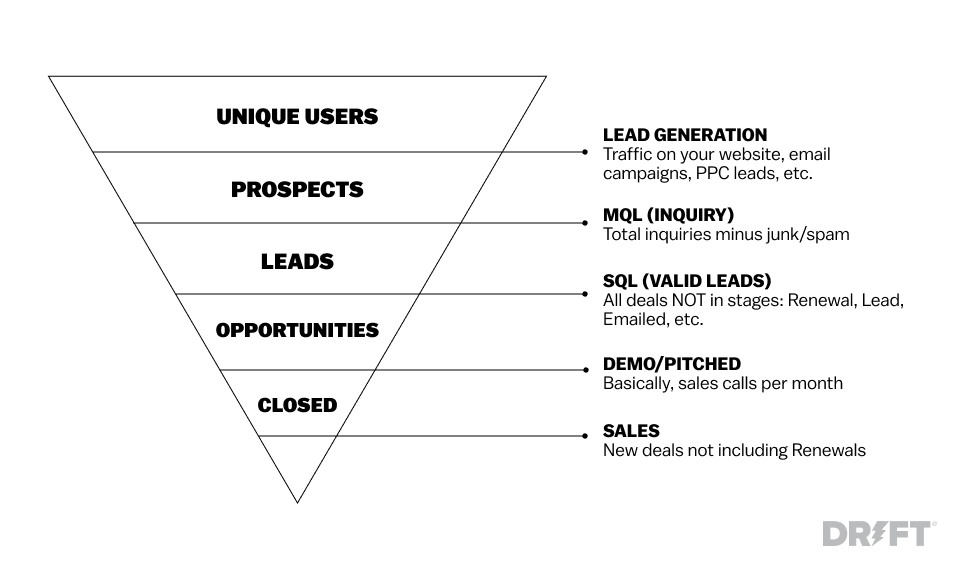
Lead scoring
Most customers, particularly in B2B, interact with marketing content way before they talk to someone on the sales team. That’s why a lead scoring system is so crucial in demand generation marketing.
A lead scoring system allows teams to maximize their sales resources by defining when exactly a prospect is receptive to direct outreach. To do this, marketing and sales teams must get together to form a unified set of definitions for what makes someone a qualified lead, a hot prospect, or on the flip side, a bad fit.
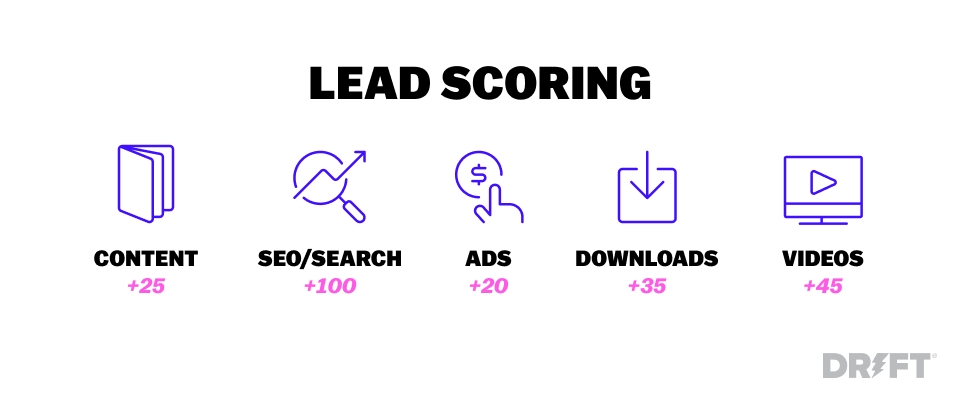
Initially, you’ll want to look at what your most successful leads have in common. Ask and answer questions like:
- Where do they work?
- What are their job titles?
- What content did they download?
- How did they find you?
Dig into the data to find out which factors had the most significant influence on sales and, from there, develop a points-based system for qualifying leads. Then, your marketing and sales teams can work together to develop a strategy for targeting the right audience.
Start developing (and promoting) downloadable resources
During the awareness stage, we mentioned that you might demonstrate your value to potential customers by offering free tools and reports.
To capture existing demand, you can use a similar strategy — only this time, offer the free resource in exchange for an email address, as opposed to a web-based tool with no strings attached.
SEO and inbound marketing
Attracting high-quality leads and converting them into customers is both an art and a science. So, while it’s important to have engaging and unique content, you also need to follow SEO best practices, hit the right keywords, and craft content that captures audience intent.
But that doesn’t mean you want to get lost in targeting specific buyer personas and keywords. Instead, think critically about what information your buyers need at every stage of their journey. Then, create content that actually answers questions people ask while focusing on long-tail, conversational keywords.
Pay-per-click advertising (PPC)
Amplify your content with paid search ads. You might use Google Ads to drive asset downloads, encourage newsletter sign-ups, or promote an e-book.
With paid search, it’s important that you place your content in front of the people actively searching for related terms. So make sure you’re aligning your digital advertising with your buyers’ intent — that way, you’ll be able to turn clicks into conversions, and potential buyers into customers.
Nurture prospects with email and remarketing campaigns
Drip marketing and remarketing campaigns keep your brand top of mind among those prospects who aren’t quite ready to buy. Tactics like buying display ads allow you to passively engage with buyers still in the evaluation stage. By connecting with buyers through email or the sites they frequent, you can incentivize prospects to come back to your website with personalized offers.
Social media & community building
It’s no surprise that social media is huge for reaching potential buyers. According to Sprout Social, nine out of 10 consumers say they will buy from brands they follow on social, and 86% will choose brands they follow over a competitor. But while social media is becoming a fundamental for demand generation marketing, social media algorithms have made organic growth much harder.
Paid promotion is essential for driving your target audience to long-form blog posts, lead magnets, and event sign-ups that will get them into the pipeline. Plus, social platforms like Facebook come with seriously powerful targeting tools like lookalike and custom intent audiences.
Not to mention, social media allows you to build a community of buyers and customers that are fans of your brand. You can help support that community by creating a space for discussion and offering trainings like we do with Champions Hub.
Conversational marketing
Conversational Marketing is a staple because it’s one of the best ways to engage buyers with targeted messaging and move buyers through the sales cycle quickly.
Instead of directing your audience to a traditional landing page with static forms, you can use conversational chatbots to answer questions, gather information, and automatically qualify leads. Additionally, chatbot software offers more context than old-school forms and can be designed to uncover pain points, intent, and the product features that are most important to the buyer.
Demand generation strategy #3: Align sales & marketing teams for better results
Organizations with a strong sales enablement strategy will have an easier time turning buyer interactions into actual revenue. To make that happen, marketers need to know exactly what happens after a lead converts and offer support to the sales team in the form of price sheets, sales decks, case studies, and more.
Today’s sales and marketing teams need to work together to give customers the best possible experience — and of course, develop a replicable process for closing deals, increasing deal size, and speeding up the sales cycle.
So, the goal of demand generation marketing here is to give sales the content they need to speak intelligently on any product, service, or segment and close more deals.
Product-specific content, playbooks, & sales decks
When marketers focus exclusively on blog posts, social, and advertising, they’re leaving out a good chunk of the buyer’s journey.
Internal content like sales decks and playbooks ensures that sellers have the information they need to maintain brand consistency and demonstrate expertise during any prospect interaction.
Case studies
Often, companies believe that their problem is so unique that no one else could possibly understand it. But most of the time you should be able to point prospects toward a client who had a similar problem.
Customer case studies are a great tool for closing the deal because they back your solutions with real-world data. Focus your case studies on benefits and results, calling out specific numbers.
But make sure to be careful about mapping case studies to specific customer segments, especially in B2B demand generation. Present buyers with a case study that doesn’t resonate with their problem and you may end up with more objections.
Testimonials
Testimonials work well at every stage of the buying journey, but they can be especially useful towards the end — when buyers are looking to validate their decision.
While customers are free to write what they want in a review, like with G2’s customer reviews, you can approach clients for testimonials so you have some control over the content. You can do this by interviewing your best customers and asking them specific questions about how your product or service benefitted them.
Whether you record a video testimonial or capture their praise in written form, you can use these testimonials across a wide range of demand generation strategies and channels.
Use the right set of demand generation tools
Another critical component of sales enablement is automating repetitive, time-consuming tasks. Organizations need to have the right tools in place, including a content repository so salespeople can easily find the right information on-demand, a customer relationship management software (CRM) that keeps contact information organized, and automations that prevent essential tasks from slipping through the cracks.
Drift Chatbots, for example, can be set up to remind salespeople to follow up, so they never forget to communicate next steps to the buyer. Before meeting with a prospect, sales reps also receive an email with a rundown of the ways they have interacted with your business — including marketing materials received, website visits, company info, and more.
On the marketing side, Drift Email helps users send marketing emails that sound natural at scale, flag potential customer issues, and route replies to the right sales rep.
Interested in how Drift can help elevate your demand gen strategy? Schedule a demo.
Demand generation vs. Lead generation
Many B2B marketing professionals use the terms “demand generation” and “lead generation” interchangeably — but they’re not the same. Demand generation raises brand awareness and increases demand for your product, while lead generation focuses on converting engaged audiences into quality leads.
Demand generation is a long-term strategy that covers all stages of the customer journey. On the other hand, lead generation is a subcategory of demand generation marketing that focuses on the top of the funnel.
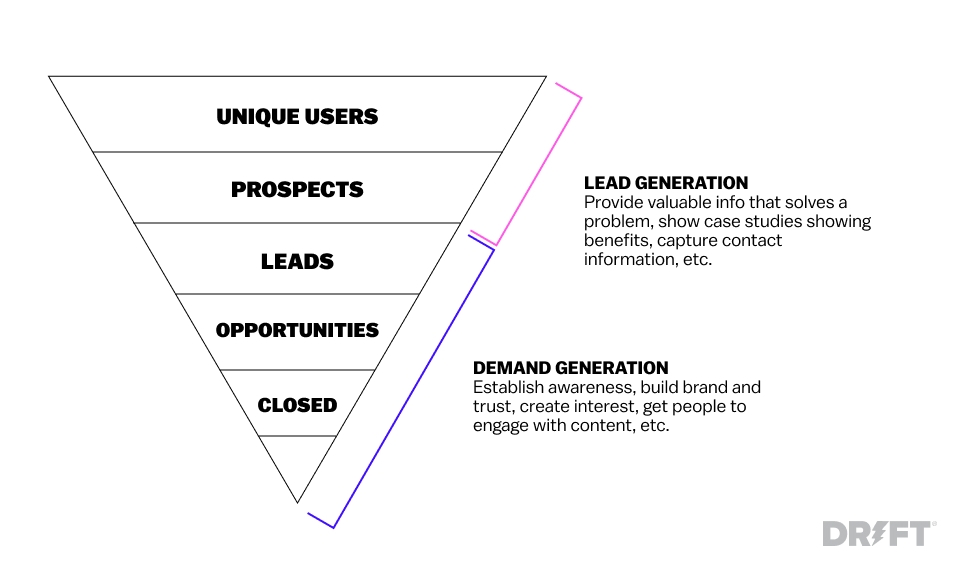
And while lead generation efforts involve collecting information from leads to nurture them into customers, demand generation is focused on putting your name out there and building trust with potential buyers.
Since you almost always want to generate both demand and leads, it’s a good idea to develop a demand generation strategy that captures leads while also providing them with the information they need at every stage of the customer journey, bringing them one step closer to becoming a customer.
Demand generation metrics: How to measure your efforts
When measuring your demand generation marketing efforts, skip the vanity metrics and instead focus on lead quality and the impact your initiatives have on your overall revenue. Here are a few examples of what demand generation metrics to measure.
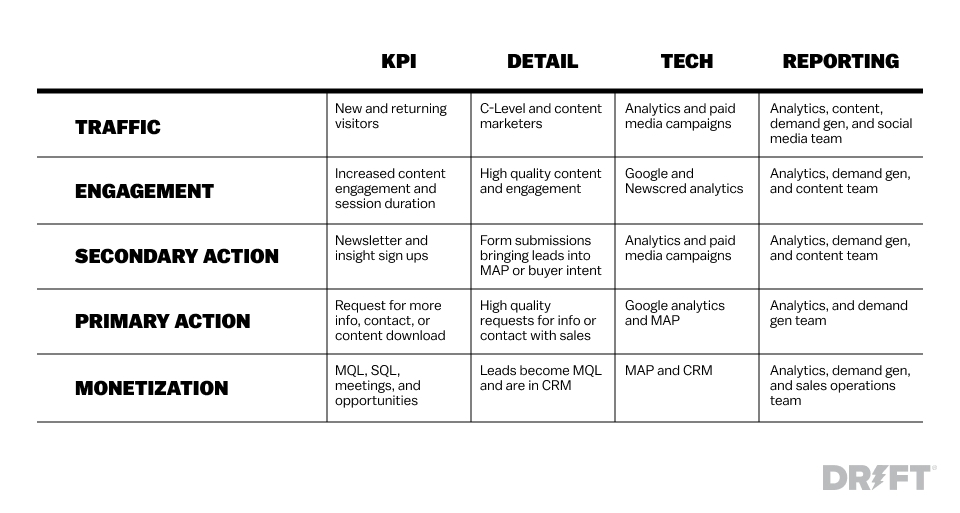
Number of meetings generated
Leads at the very top of the funnel are a leading indicator that your offers are appealing to your audience — but, if those leads don’t have decision-making power, they aren’t going to help grow your business.
So instead, track the number of visitors who book a sales meeting — be it a discovery call or demo — to gauge how many high-quality leads you are acquiring through your demand generation marketing.
Number of opportunities generated
Another metric that will help you understand the quality of your demand generation marketing is the number of leads that turn into actual opportunities. This gives you insight into the quality of your leads while also allowing you to evaluate your lead scoring system.
Quick tip: If you’re using chatbots, don’t compare the conversion rates between a traditional landing page with a form against a chatbot. Instead, check the lead to opportunity conversion rate for leads that originate through your chatbot vs. leads from other sources
Average deal size
Your average deal size represents the average value of each new customer in dollars. You can figure this out by dividing total revenue by the number of deals closed in a given time period.
Knowing your average deal size helps you forecast revenue from demand generation campaigns and decide what types of customers you should target and prioritize. And, by figuring out the average deal size of each channel, you can get a more granular view of your marketing return on investment (ROI).
Sales pipeline value
In order to make sure your sales reps are on track to reach their goals, you can look at your sales pipeline value. This refers to the combined revenue from every qualified opportunity in your pipeline, which can be calculated by simply adding the estimated deal size for all leads in your pipeline.
You can also measure your marketing team’s success by looking at marketing’s contribution to the sales pipeline as a percentage. By calculating the amount of marketing sourced pipeline, your sales team will have a better idea of how many deals they need to source via outbound efforts.
Customer acquisition cost
Checking how many clicks you get on your CTAs is all well and good, but what really matters is whether your demand generation campaigns are generating revenue. Your customer acquisition cost (CAC) tells you how much you spent to acquire a single paying customer from a specific demand generation campaign.
To calculate it, divide the total campaign cost by the number of customers acquired during the period you spent that money. When measuring CAC, you can also take into account the marketing headcount needed to manage and create these campaigns. This measurement of CAC is imporant for showing investors and company leaders how efficient you are at acquiring new business.
Cost per lead
Similar to the previous demand generation metric, cost per lead tells you how much you spent to acquire a single lead. You can calculate this by dividing your total campaign costs by the number of leads that come in.
Cost per lead tells you how efficient your demand generation campaign is, and it’s useful for figuring out how much you need to spend to keep your funnel full. On the flip side, you can set a limit on your cost per lead to ensure you don’t spend more on acquiring leads than you would get back in revenue. So, keep this metric in mind when planning new demand generation campaigns and calculating your demand generation ROI.
Customer lifetime value
How much will a customer spend over the course of their relationship with you? Customer lifetime value (CLV) measures the average profit you can expect to make per customer. It also reveals how well you’re managing and engaging with your customers, and if there’s room for improvement. You can measure this by calculating the average purchase value, then multiplying that number by the average purchase frequency rate.
Average sales cycle length
How long does it take you to close a deal? Average sales cycle length provides a clear timeframe from first touch to a signed contract. To figure this out, add the time to conversion for every stage of your funnel. You can also measure the length of your sales cycle by channel to determine which channels to prioritize in your demand generation campaigns.
It’s also important to understand how long your sales cycle is because this tells you when you can expect to see the full impact of your campaigns. If you know how long it takes for a lead from a specific channel to close, you can plan your demand generation campaign backwards and map out the interactions and marketing offers you will need to have throughout that cycle.
Revenue generated against budget investment
In essence, this is a measure of your company’s profitability — so you can’t leave this one out. This metric tells you how much revenue you’ve earned from your demand generation marketing. To calculate it, take the amount generated from a campaign, subtract the marketing costs, then divide that number by the marketing cost.
Demand generation benchmarking data
Before you dive into planning and executing some new demand generation campaigns, it’s worth looking at what other marketers are saying about their own demand generation initiatives.
Here are several recent demand generation benchmarks to give you an idea of how much companies are investing in demand generation, what they’re prioritizing, and the impact they’ve seen.
Demand generation budget
- For the past few years, marketing leaders have stated that generating pipeline is their biggest priority — 55% in 2020 and 53% in 2021. (Marketing Leadership Benchmark Report)
- In 2022, 69% of marketers indicated their demand generation budgets will increase between 1% and 20%. (Demand Gen Report)
- The top three areas marketing teams plan to invest in are content marketing (58%), ABM (47%), and sales enablement (46%). (Demand Gen Report)
- Marketers stated that their biggest initiative was testing and deploying marketing automation (39%). (Demand Gen Report)
ABM solutions
- Since 2020, buyer demand for personalized experiences has increased by 26% year-over-year. (State of Conversational Marketing)
- 86% of self-identified unproductive sellers believe a lack of qualified buyers in their pipeline is their biggest challenge. (State of Conversational Sales)
- Demand generation marketers are focusing on reaching the right buyers, with 30% saying improving lead quality over quantity is their most important priority (with 41% naming it an important priority). (Demand Gen Report)
- With AI, 41% of marketers said they were creating personalized experiences at scale, and 40% were getting more actionable insights from marketing data. (State of Marketing and Sales AI)
Driving demand at all stages of the funnel
- In 2021, the demand for immediacy in almost every communication channel grew by an average of 64% year-over-year. (State of Conversational Marketing)
- 45% of marketers said webinars were their top engagement tactic for qualifying leads at the top of the funnel. (Demand Gen Report)
- Marketers said webinars (36%) and case studies (33%) were the most successful tactics for converting leads in the middle and late stages of the funnel. (Demand Gen Report)
- 49% of marketers said email was their top channel to drive leads into pipeline. (Demand Gen Report)
Demand generation goals & strategies
- 42% of demand generation marketers indicated that their biggest goal is to better align marketing and sales departments around go-to-market initiatives. (Demand Gen Report)
- To boost alignment, marketers said they would focus on ensuring sellers are following up with leads (61%), deploying ABM tactics (52%), and leveraging intent data (47%). (Demand Gen Report)
- With demand generation initiatives, 49% of marketers actively measure campaign performance and 37% say they plan to start this year. (Demand Gen Report)
- For both marketers and sellers, the top individual use case for AI was measuring channel, campaign, and overall ROI. (State of Marketing and Sales AI)
Drive business growth with our conversation cloud
With how broad demand generation marketing is, it can get hard to keep your all initiatives in order — while making sure that all of your efforts are actually driving demand.
So, why not make your life a little easier? Drift Conversation Cloud brings all your revenue teams together with just one goal in mind: to have the right conversation with the right person at the right time. Whether you’re in marketing, sales, or support, our platform ensures you’re having relevant, meaningful conversations with your buyers and customers — all the time.
Or, if you want to take a sneak peek at what Drift can do to boost your demand generation, here’s how we use Drift (and more) to drive marketing and sales alignment.





























